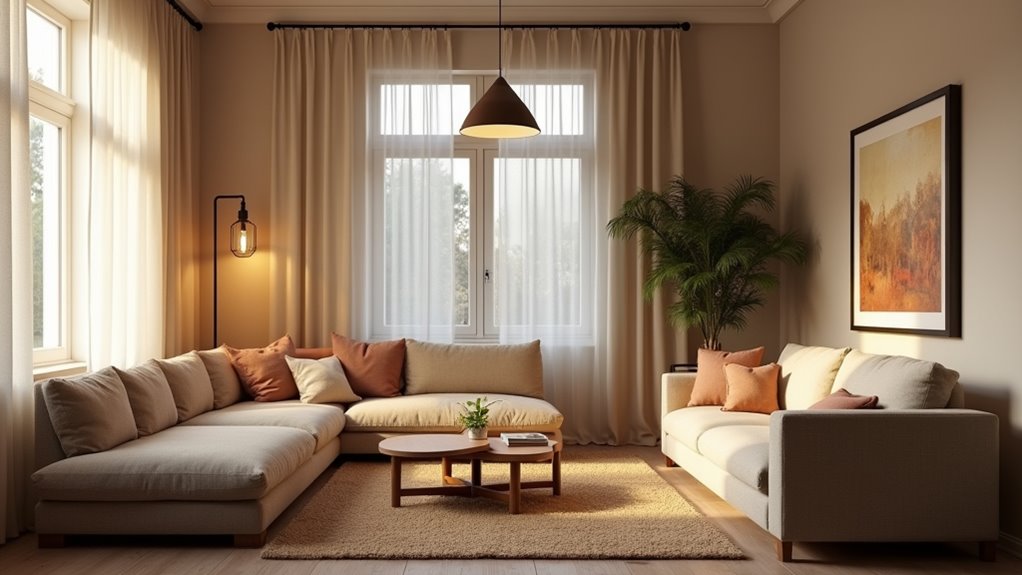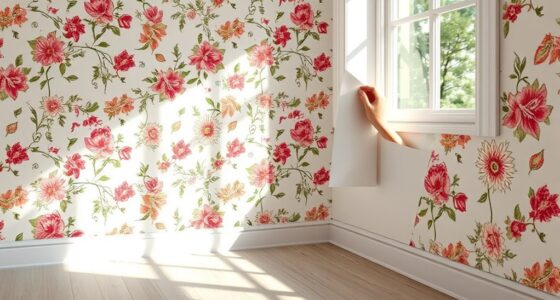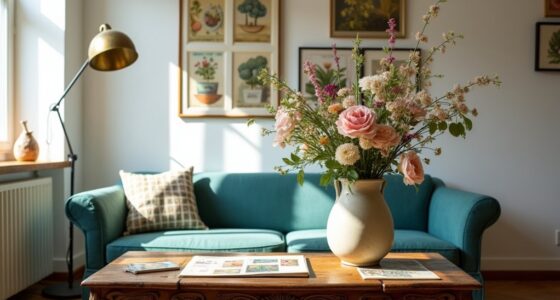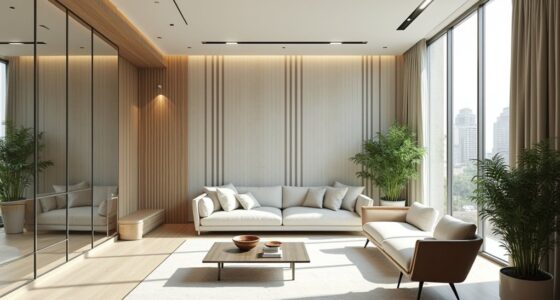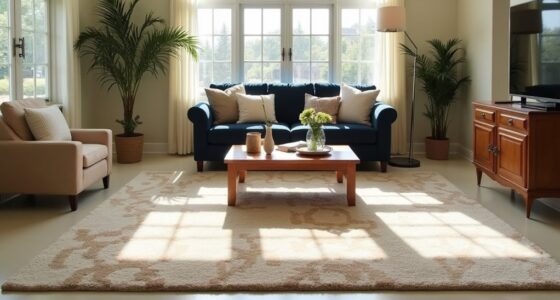To layer lighting effectively in any room, combine ambient, task, and accent lighting. Start by ensuring your ambient lighting provides around 20 lumens per square foot for general visibility. Then, add task lighting with at least 50 lumens per square foot for specific activities. Finally, use accent lighting to enhance features, making it three times brighter than your ambient lighting. With the right mix of fixtures and placement, you can transform your space beautifully. You’ll discover more tips to achieve this!
Key Takeaways
- Combine ambient, task, and accent lighting to create a versatile and inviting atmosphere in any room.
- Ensure ambient lighting provides about 20 lumens per square foot for general visibility.
- Utilize task lighting with at least 50 lumens per square foot to support specific activities.
- Position accent lighting to be three times brighter than ambient lighting to highlight features and details.
- Incorporate natural light with reflective surfaces and strategic window treatments for a balanced illumination.
Understanding Layered Lighting
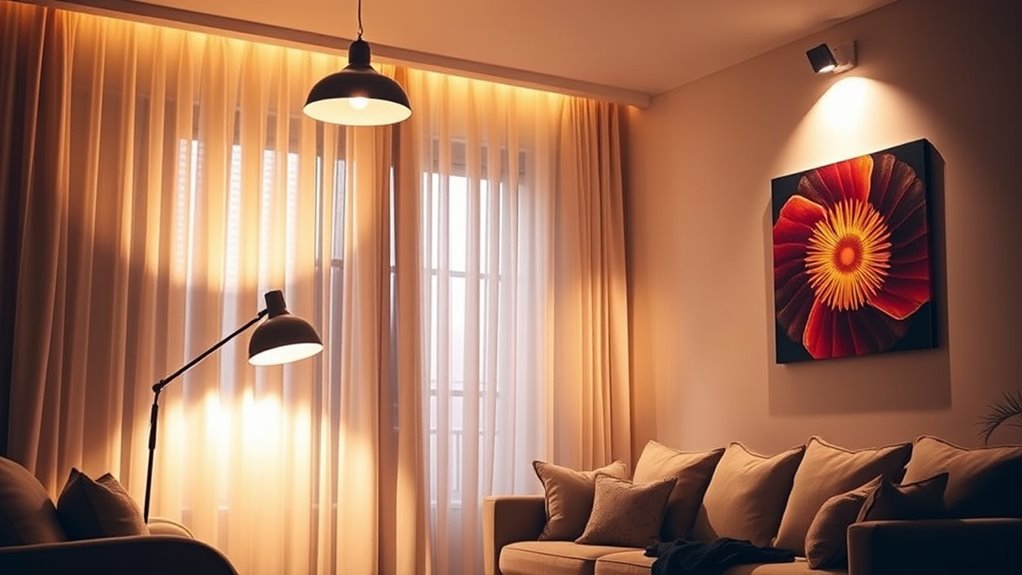
When you think about creating a comfortable and functional space, understanding layered lighting is essential.
Layered lighting combines ambient, task, and accent lighting to craft a well-balanced illumination scheme. Ambient lighting provides general visibility, ideally around 20 lumens per square foot, while task lighting focuses on specific activities, requiring about 50 lumens per square foot. Additionally, using different materials and textures in your light fixtures can enhance the overall aesthetic appeal of your space. Incorporating effective preparation in your lighting design process can also lead to better outcomes. Proper installation of your lighting fixtures can ensure both safety and efficiency, contributing to the overall effectiveness of the layered lighting approach.
Accent lighting highlights key features, needing to be three times brighter than the ambient light to draw attention effectively. This layered approach allows for mood adjustments, enabling you to shift between various activities and atmospheres throughout the day. Additionally, incorporating lighting design into your overall interior scheme can greatly enhance the ambiance and functionality of your space.
The Three Key Types of Lighting
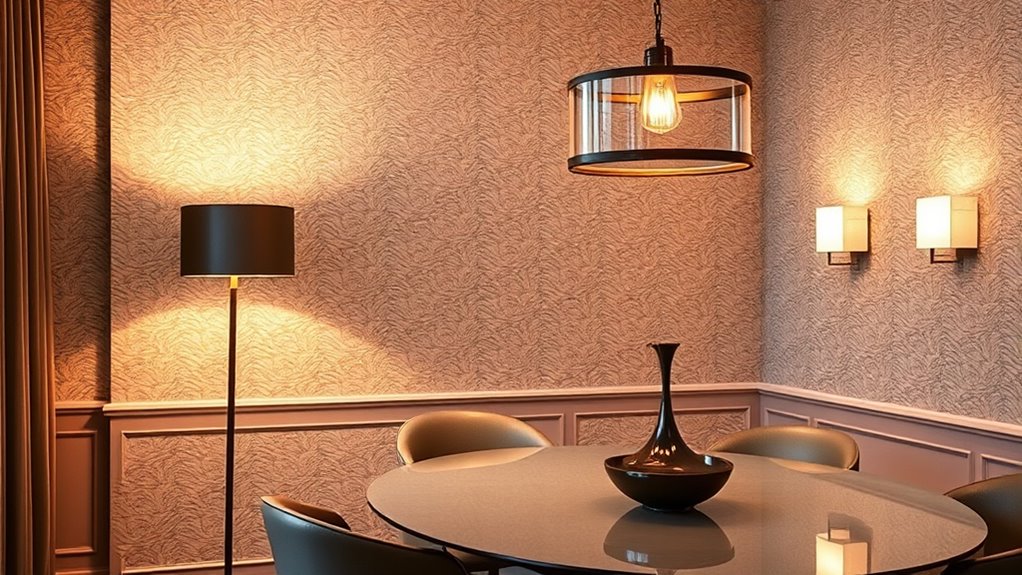
Understanding the three key types of lighting—ambient, task, and accent—can greatly enhance your space’s functionality and aesthetic appeal.
Ambient lighting provides general illumination, ideally around 20 lumens per square foot, ensuring visibility. Regularly checking power manager status can help maintain optimal performance in your lighting system. Utilizing HEPA filters in air purifiers can also improve indoor air quality, making your space more comfortable.
Task lighting focuses on specific activities, like reading or cooking, delivering at least 50 lumens per square foot with adjustable brightness for your needs.
Accent lighting highlights features such as artwork or architectural details and should be three times brighter than ambient lighting for maximum impact. By combining these lighting options through layered lighting, you create depth and dimension in your room.
Using multiple light sources strategically not only enhances your lighting design but also gives you the versatility to transform your space with simple lighting tips. Incorporating weather-resistant materials can also ensure that outdoor lighting solutions remain effective and durable.
Essential Tips for Layering Light
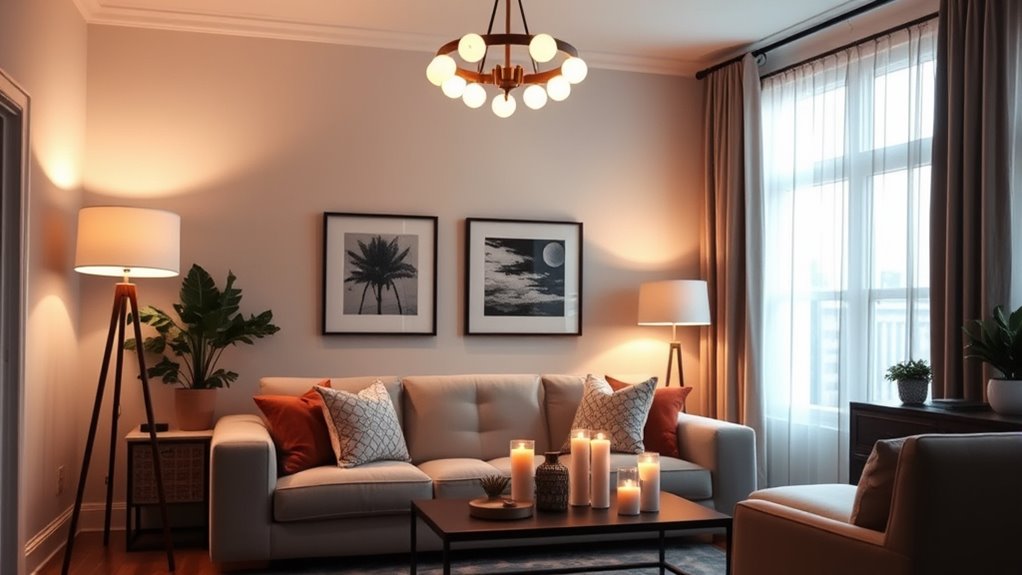
To create a well-lit and inviting space, layering light effectively is essential. Start by combining ambient, task, and accent lighting to achieve a versatile atmosphere. Aim for about 20 lumens per square foot for ambient lighting, while task lighting should provide around 50 lumens for activities like reading or cooking. Use a mix of light fixtures—think chandeliers, wall sconces, and table lamps—to create a layered look that adds visual interest and dimension. Additionally, consider incorporating energy-efficient LED fixtures to enhance sustainability and reduce electricity costs. Regularly updating these fixtures can also contribute to energy efficiency in your home. Exploring cultural festivals in your area can inspire creative lighting themes based on local heritage.
Incorporate dimmers on your light fixtures to adjust brightness, enhancing the room’s atmosphere based on the time of day. Strategically position lamps to maintain balance and avoid overly bright spots, ensuring a cohesive and inviting environment throughout your lighting system. Additionally, consider integrating smart lighting systems to improve ambiance and reduce energy use.
Incorporating Natural Light
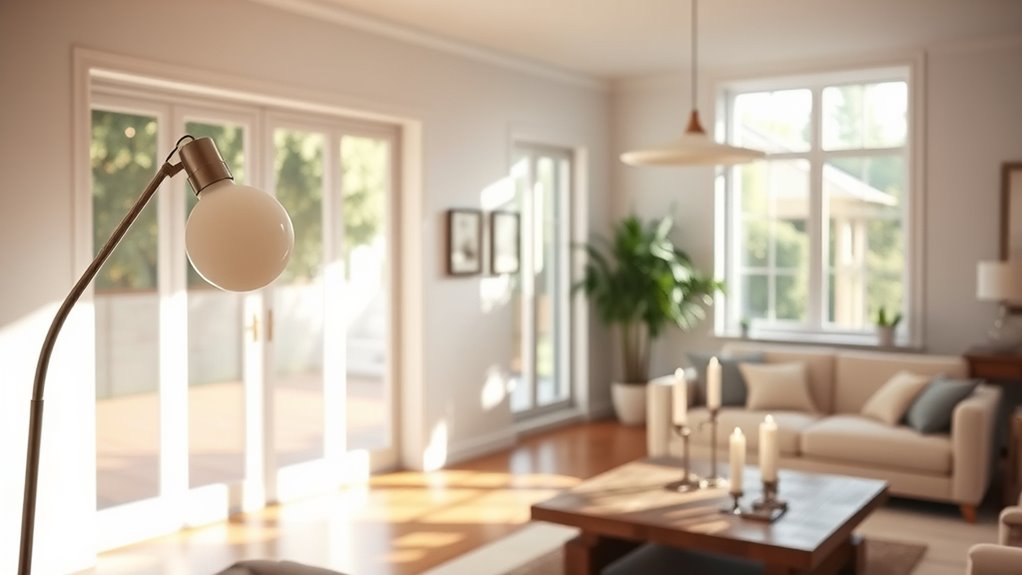
Layering artificial lighting creates a warm and inviting atmosphere, but don’t overlook the power of natural light.
To enhance the ambiance of your room, strategically assess your lighting layout by considering the size and orientation of your windows. This will help you understand how much natural light floods in at different times of the day. Additionally, incorporating reflective surfaces can significantly amplify the brightness in your space. Using smart shopping techniques can also help you find the best lighting options that maximize the benefits of natural light. A well-lit environment can also promote digestive health and overall well-being.
Strategically assess window size and orientation to maximize natural light and enhance your room’s ambiance.
Incorporate reflective surfaces, like mirrors, to bounce sunlight around, making the space feel brighter. Use sheer curtains made from light fabrics to diffuse direct sunlight while still allowing ample natural light to enter.
For a more dramatic effect, think about adding skylights or larger windows. This not only boosts natural light sources but also promotes energy efficiency, reducing your reliance on artificial lighting. Additionally, embracing mindful consumption can further enhance your living space by ensuring that the items you choose to keep complement the natural light and overall aesthetic.
Creating a Balanced Atmosphere
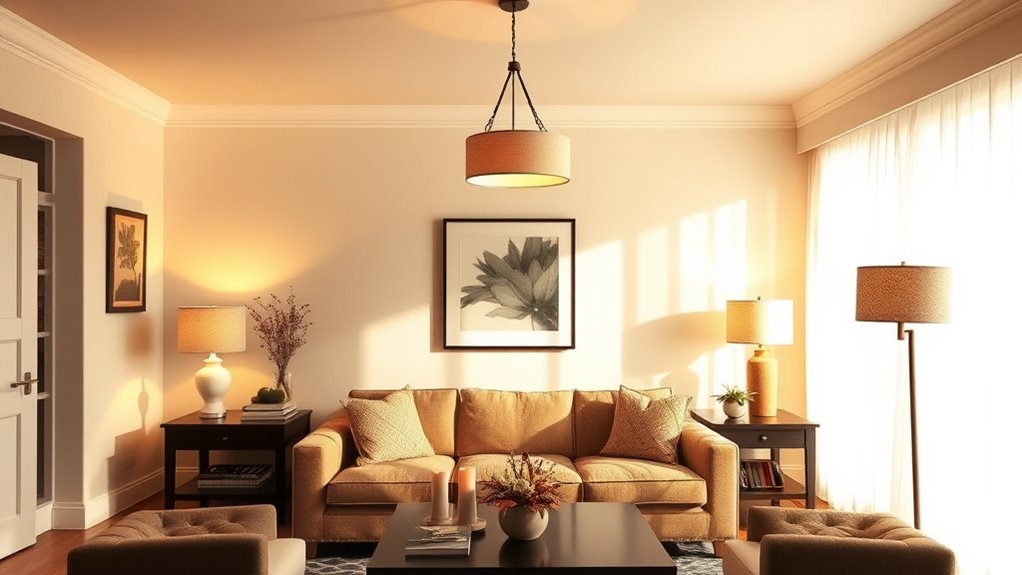
Creating a balanced atmosphere in your space not only enhances its aesthetic appeal but also improves functionality. To achieve this, incorporate ambient, task, and accent lighting as distinct yet harmonious layers. Aim for 20 lumens per square foot for ambient lighting, ensuring general illumination flows throughout. For focused activities like reading or cooking, task lighting should provide around 50 lumens per square foot. Accent lighting, designed to highlight features, should be three times brighter than your ambient lighting. Additionally, using multi-functional furniture can help optimize both lighting and space in your room. Consider integrating strategic lighting to further enhance the overall ambiance and highlight important design elements. Furthermore, creating a serene environment can contribute to your overall mental wellbeing, which is essential for a balanced lifestyle. Understanding the importance of budgeting is also crucial when planning for home improvements and lighting enhancements.
Frequently Asked Questions
How to Layer Lighting in a Room?
To layer lighting in a room, start with ambient lighting for general illumination, aiming for about 20 lumens per square foot.
Next, add task lighting, like desk lamps or under-cabinet lights, delivering around 50 lumens per square foot for specific activities.
Finally, incorporate accent lighting to highlight features, ensuring it’s brighter than the ambient light.
Mix fixtures like chandeliers and sconces, and consider dimmers to adjust brightness based on your mood and needs.
What Are the 3 Basic Types of Layered Lighting in a Room?
Did you know that proper lighting can boost your mood by nearly 20%?
In any room, you’ve got three basic types of layered lighting to evaluate.
First, ambient lighting provides general illumination, allowing you to navigate comfortably.
Next, task lighting focuses on specific activities, giving you the brightness you need for work.
Finally, accent lighting highlights features like artwork, creating a visually appealing atmosphere.
Combining them creates a dynamic and inviting space.
How to Arrange Can Lights in a Room?
To arrange can lights in a room, start by spacing them about 4-6 feet apart for even illumination.
Position them 2-3 feet away from walls to avoid harsh shadows. If you’re focused on task lighting, consider adding more lights to achieve 50 lumens per square foot.
Don’t forget to use dimmers for adjustable brightness, and make sure they’re placed 8-9 feet above the floor for maximum effectiveness.
This’ll create a well-lit space.
What Is the Golden Rule of Lighting?
Imagine a room bathed in soft, warm light, contrasting with harsh shadows lurking in the corners.
The golden rule of lighting emphasizes layering your light sources—ambient, task, and accent—to create depth and versatility.
You’re not just illuminating; you’re crafting an atmosphere.
Conclusion
Incorporating layered lighting transforms your space, turning it from a dim cave into a vibrant haven. By blending ambient, task, and accent lighting, you create a symphony of illumination that dances across your walls. Don’t forget to invite natural light to join the party, enhancing the warmth and character of your room. With these tips, you’ll cultivate an inviting atmosphere that not only highlights your decor but also reflects your unique style. Embrace the glow and let your home shine!
